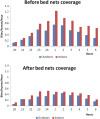Impact of cyfluthrin (Solfac EW050) impregnated bed nets on malaria transmission in the city of Mbandjock : lessons for the nationwide distribution of long-lasting insecticidal nets (LLINs) in Cameroon
- PMID: 23311927
- PMCID: PMC3556121
- DOI: 10.1186/1756-3305-6-10
Impact of cyfluthrin (Solfac EW050) impregnated bed nets on malaria transmission in the city of Mbandjock : lessons for the nationwide distribution of long-lasting insecticidal nets (LLINs) in Cameroon
Abstract
Background: Insecticide treated materials remain the mainstay for malaria prevention. The current study reports on the entomological impact of cyfluthrin impregnated bed nets on malaria transmission in Mbandjock, a semi urban locality in southern Cameroon. Several findings pertaining to the recent distribution of LLINs across Cameroon are discussed.
Methods: Malaria transmission and vector bionomics were monitored before and after impregnated net coverage. Bed nets were distributed in Mbandjock, whereas the locality of Nkoteng was free of bed nets during the entire study period. January to June 1997 represented the period before bed net coverage and September 1997 to September 1998 was the period after bed net coverage. Adult mosquitoes were collected by human landing catches. Mosquito genus and species were identified with morphological and molecular diagnostic tools. Anopheline salivary glands and ovaries were dissected to determine female infectious status and parity rates respectively.
Results: A total of 6959 anophelines corresponding to 6029 in Mbandjock and 930 in Nkoteng were collected in the course of the study. Seven species were recorded in both cities : Anopheles coustani, An. funestus, An. gambiae sl, An. moucheti, An. ziemanni, An. nili and An. paludis. An. gambiae s.l. (>95% An. gambiae S molecular form) was the most abundant species representing 75.6% and 86.6% of the total anophelines caught in Mbandjock before and after bed net coverage respectively. The human biting rate (HBR) in Mbandjock decreased from 17 bites/human/night before bed net coverage to less than 4 bites/human/night during the first 7 months following impregnated bed net coverage. A significant decrease of mosquito parity rate was recorded when comparing the period before (52%) and after (46.5%) bed net distribution. The average infection rate of malaria vectors significantly decreased from 5.3% before to 1.8% after bed net coverage (p < 0.0001). The entomological inoculation rate in Mbandjock was reduced by 74% varying from 124.1 infected bites/human/year before bed net distribution, to 32.5 infected bites/human/year after bed net coverage. All entomological indexes were relatively stable in Nkoteng and no reduction of malaria transmission was recorded in this locality.
Conclusion: The study confirms the effectiveness of cyfluthrin impregnated nets in reducing malaria transmission. Lessons from this study could be essential to draw guidelines for the management of the recent nationwide distribution of LLINs across Cameroon in 2011.
Figures




References
-
- Amara/Mara. Towards an atlas of malaria risk in Africa. Mapping malaria risk in Africa/Atlas du risque de la malaria en Afrique, Durban; 1998. First technical report.
-
- World Health Organization. World Malaria Report 2011 Geneva, Switzerland. 2011.
-
- RBM. Roll Back Malaria: Global strategic plan 2005–2015. 2005.
-
- Antonio-Nkondjio C, Kerah C, Simard F, Awono-Ambene H, Mouhamadou C, Tchuinkam T, Fontenille D. Complexity of malaria vectorial system in Cameroon: contribution of secondary vectors to malaria transmission. J Med Entomol. 2006;43:1215–1221. doi: 10.1603/0022-2585(2006)43[1215:COTMVS]2.0.CO;2. - DOI - PubMed
-
- RBM. Le paludisme en Afrique rapport du paludisme au Cameroun 2001 à 2010 décennie des Nations Unies pour faire réculer le paludismeRBM/OMS/UNICEF/PNUD/Banque Mondiale. 2005.
Publication types
MeSH terms
Substances
Grants and funding
LinkOut - more resources
Full Text Sources
Other Literature Sources
Medical

